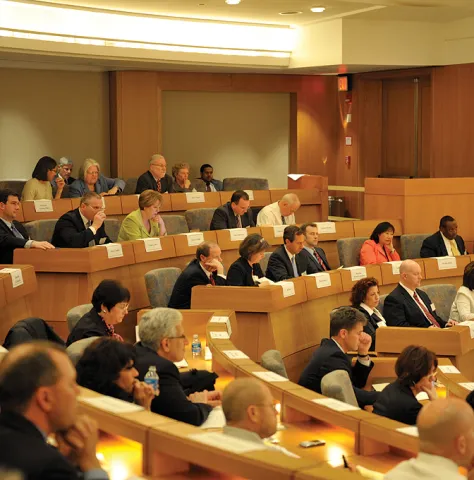
By renewing its strategic plan, the Judiciary will enhance its focus on key challenges and trends.
Courtroom Policies and Studies
Based on the findings of a 2008 study by the Federal Judicial Center (FJC) of courtroom use in district courts, the Committee on Court Administration and Case Management (CACM) proposed, and, at its meeting in September 2009, the Judicial Conference adopted, a courtroom sharing formula for magistrate judges. This formula, which was developed in consultation with the committees on the Administration of the Magistrate Judges System and on Space and Facilities, provides one courtroom for every two magistrate judges, plus one additional courtroom in courthouses with three or more magistrate judges, to ensure that a courtroom would be available in a timely manner for criminal duty proceedings. It also contains a number of issues to be considered by the Space and Facilities Committee, should an exemption from the policy be requested. The FJC is continuing its study of courtroom use in bankruptcy courts, with a report expected to the CACM Committee by its meeting in December 2010.
Judiciary Planning
An Ad Hoc Advisory Committee on Judiciary Planning has been working since the fall of 2008 to develop a new strategic plan for the Judiciary, and to establish an ongoing process to sustain planning efforts. The Committee includes judges who are current or recent Judicial Conference committee chairs or Executive Committee members, as well as two circuit executives, a clerk of court, and the AO Director.
The Advisory Committee produced a draft strategic plan intended to complement current mechanisms for policymaking and administration and preserve the Judiciary’s excellence in delivering equal justice under the law. The draft plan is organized around a set of strategic issues—fundamental policy questions or challenges reflecting key trends. The draft plan, including goals to enhance the Judiciary’s accessibility, timeliness and efficiency; its ability to attract and retain highly competent judges and staff; the effectiveness of its relationships with Congress and the executive branch; and the trust and confidence of the public.
Strategic Planning for Circuit Libraries
AO staff continued to work with circuit librarians on strategic planning. Issues discussed included potential improvements in legal research service delivery; raising awareness of library services; library collection development policies; and, increasing staff skills—particularly with new technology. Librarians identified several action items for follow-up. Several libraries invited AO staff to assist in local strategic planning sessions and implementation of changes.
As the year ended, the Court Administration and Case Management Committee requested that the Administrative Office work with librarians and others to determine how a significant reduction in law book funding in FY 2012 and beyond would impact court libraries and library services. The focus of the study is on the new role of libraries in the digital age and will include an investigation and report on the potential savings to be gained with clear options for change.
Audits and Program Reviews

Courts often streamline business operations, add staff training, and adopt best practices after Judiciary audits and program reviews are conducted.
The Administrative Office conducts financial audits, reviews, assessments, and evaluations to promote effectiveness, efficiency, and economy in both AO and court operations. The AO’s Office of Audit carries out a comprehensive program of financial audits covering all court units, Judiciary funds, and financial systems. Court audits are conducted on a four-year cycle for most courts, and on a 30-month cycle for larger courts. In 2009, the Administrative Office issued final reports for 51 cyclical financial audits of the courts. It completed 50 other financial audits, including audits of Chapter 7 trustees, Criminal Justice Act grantees, and audits in response to a change of clerk and to follow up on prior reviews.
As a result of Section 603 of the Bankruptcy Abuse Prevention and Consumer Protection Act of 2005, required audits of randomly selected debtors began in 2007 to determine the accuracy, veracity, and completeness of the information contained in the petitions, schedules, and statements filed by individual Chapter 7 and 13 debtors; 304 debtor audits were conducted in 2009.
Each year, on-site management assistance and program reviews of various kinds are conducted in the courts. Reviews may cover jury administration, court reporting, program operations and management, human resources management, property management, procurement, information technology operations, security, and continuity of operations plans and disaster preparedness. Review procedures generally include observations of office operations, interviews with key staff, and the evaluation of records and files.
During fiscal year 2009, on-site reviews were conducted in two appellate courts, five district courts, six bankruptcy courts, 17 federal defender organizations, and 21 probation/pretrial services offices in 19 districts. In addition, the AO, upon request, conducted comprehensive reviews of one circuit library program and of the automation program in another circuit in FY 2009. Areas for service enhancements, staff training, and streamlined operations were addressed.
Annual Report 2009
- Annual Report 2009
- Legislative Activity
- Direct Impact On The Public
- Judges Programs
- Facilities, Security, and Emergency Planning
- Business Improvements, Studies, and Activities
- Key Studies and Activities
- Human Resources
- Technology
- Probation and Pretrial Services
- Defender Services
- Communications
- In Profile
- A Strategic Direction For The Administrative Office of the United States Courts, Fiscal Years 2009–2013
